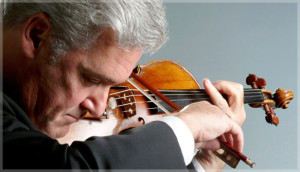
 The headline tells it all; the writer will elaborate briefly for readers who have not heard Pinchas Zukerman play or who wonder about Beethoven and the violin. However, the available superlatives all fall away in remembering this musical experience. On January 26, 2014, Pinchas Zukerman was both the conductor and the solo violinist for London’s Royal Philharmonic performing three works by Beethoven: Overture to The Creatures of Prometheus; Violin Concerto in D maj; Symphony No. 5. One could say it was a celestial experience if it were not that Beethoven insists upon being an earthling. The music rips right into whatever it means to be human, the myriad things it means to be human, and celebrates life here on earth. The people wanting to build that foul pipeline of tar sands oil across American lands could never have heard Beethoven. Oddly enough, Beethoven’s music somehow encompasses even them. Mr. Zukerman’s low key approach to conducting is deceptive. Those who have witnessed famous adults and highly skilled ten year olds dramatically waving their violin bows in order to tell their audience when they are playing something important and when they are ready for an ovation might find the absence of dramatics disappointing, but his style allows the music to be the only focal point. Mr. Zukerman’s playing is masterful, a joy. In the lengthy concerto it ranged from exquisite simplicity to complex, virtuosic performance that left one breathless. The concerto’s last movement is a delightful dance. The theme sounds like fun, but it is able to be playful because it dances on top of such musical complexity and Beethovenian energy. One moment in Mr. Zukerman’s performance particularly revealed how thoroughly he lives in the music. His back to the audience, he conducted with spare movements and played. He then turned toward the audience, lifted violin to chin, bow to violin, and began to play his solo part. The time between is what fascinated me. He knew physically exactly how long he had to make that 180 turn and begin to play. No rush. Mr. Zukerman would be great at the most challenging jump rope routines. Everyone has heard the 5th Symphony or at least knows how it begins. It was the theme for the Huntley/Brinkley news decades ago. It was the Victory symphony in World War II. The problem with something that we all think we know is that we often forget to listen to it. The Royal Philharmonic and Pinchas Zukerman’s performance of Beethoven’s 5th Symphony transmitted the greatness of Beethoven’s sense of life. It is possible to hear it telling the tale of human being, alone and together. The music stretches the reach of what we want to think of as Western Civilization, of Culture with the largest Capital C, of human potential good and bad. At the end, when the clowns, chimpanzees, whales, toddlers, miners, mothers, trees, lilies, and weeds, are all in the music, exuberant with life moving in every cell, the listener is elevated to thrill in being. This listener levitated above the crowded staircase out the symphony through the traffic to find her car had been smashed and robbed. This listener, reminding herself that even that was included in the 5th Symphony, even those who want to build the pipeline, was thankful to have heard it.
The headline tells it all; the writer will elaborate briefly for readers who have not heard Pinchas Zukerman play or who wonder about Beethoven and the violin. However, the available superlatives all fall away in remembering this musical experience. On January 26, 2014, Pinchas Zukerman was both the conductor and the solo violinist for London’s Royal Philharmonic performing three works by Beethoven: Overture to The Creatures of Prometheus; Violin Concerto in D maj; Symphony No. 5. One could say it was a celestial experience if it were not that Beethoven insists upon being an earthling. The music rips right into whatever it means to be human, the myriad things it means to be human, and celebrates life here on earth. The people wanting to build that foul pipeline of tar sands oil across American lands could never have heard Beethoven. Oddly enough, Beethoven’s music somehow encompasses even them. Mr. Zukerman’s low key approach to conducting is deceptive. Those who have witnessed famous adults and highly skilled ten year olds dramatically waving their violin bows in order to tell their audience when they are playing something important and when they are ready for an ovation might find the absence of dramatics disappointing, but his style allows the music to be the only focal point. Mr. Zukerman’s playing is masterful, a joy. In the lengthy concerto it ranged from exquisite simplicity to complex, virtuosic performance that left one breathless. The concerto’s last movement is a delightful dance. The theme sounds like fun, but it is able to be playful because it dances on top of such musical complexity and Beethovenian energy. One moment in Mr. Zukerman’s performance particularly revealed how thoroughly he lives in the music. His back to the audience, he conducted with spare movements and played. He then turned toward the audience, lifted violin to chin, bow to violin, and began to play his solo part. The time between is what fascinated me. He knew physically exactly how long he had to make that 180 turn and begin to play. No rush. Mr. Zukerman would be great at the most challenging jump rope routines. Everyone has heard the 5th Symphony or at least knows how it begins. It was the theme for the Huntley/Brinkley news decades ago. It was the Victory symphony in World War II. The problem with something that we all think we know is that we often forget to listen to it. The Royal Philharmonic and Pinchas Zukerman’s performance of Beethoven’s 5th Symphony transmitted the greatness of Beethoven’s sense of life. It is possible to hear it telling the tale of human being, alone and together. The music stretches the reach of what we want to think of as Western Civilization, of Culture with the largest Capital C, of human potential good and bad. At the end, when the clowns, chimpanzees, whales, toddlers, miners, mothers, trees, lilies, and weeds, are all in the music, exuberant with life moving in every cell, the listener is elevated to thrill in being. This listener levitated above the crowded staircase out the symphony through the traffic to find her car had been smashed and robbed. This listener, reminding herself that even that was included in the 5th Symphony, even those who want to build the pipeline, was thankful to have heard it.
Tag Archives: San Francisco Symphony
Barantschik, Zukerman, Kremer: Great Violinists in San Francisco, Part I
 Part I: Music lovers in San Francisco had a festival of great violinists from late January to Groundhog’s Day. It was easy to forget the inevitable post-holiday let down when in the presence of artistry that lifted the spirit while demanding an open heart and mind. Alexander Barantschik, San Francisco Symphony’s Concertmaster, was leader and soloist on Jan. 22, 2014, when members of the SFSymphony joined him in works by Mozart, Mendelssohn, Britten, and Piazzola. With the exception of Piazzola’s works, each composer wrote the selections when very young. Very young: Mozart was 16 when he wrote Divertimento in F maj.; Mendelssohn was 13 when he wrote Concerto in D min. for Violin and String Orchestra; Britten was 10-13 when he wrote the themes, songs, and tunes which he made into Simple Symphony when he was 20. The words charming, delightful, beautiful are the ones which instantly come to mind for the Mozart Divertimento. The second movement Andante has a delicious lyrical, nearly seductive style. It ends with a Rondo which is bright and exciting. The players did so well capturing the light-on-water brilliance. Barantschik’s playing in the Mendelssohn Concerto had all the virtuosic abilities the piece deserves. He is an appropriate inheritor of the piece which was written for Eduard Rietz, the violinist to whom Mendelssohn dedicated important works and who was Concertmaster when Mendelssohn revived Bach’s Saint Matthew Passion. Before joining the SFS, Barantschik served as concertmaster of the London Symphony Orchestra. San Franciscans are fortunate to hear his performances with the orchestra and in chamber performances. The Concerto is full of energy and musical invention. Mendelssohn demonstrates his ability to see the many different dimensions in which the music can be arranged, altering the order of phrases and finding new combinations for them. Never more devoted to chess playing than to music making, the young genius gives us music that thrills the audience. Britten’s Simple Symphony was a surprise to audience members who know Britten only through “heavy” music like operas Turn of the Screw. This was fun and tuneful. The four movements, Boisterous Bourree, Playful Pizzicato, Sentimental Saraband, Frolicsome Finale, live up to their titles to create a frolicsome suite. The musicians played with relish. I first heard Piazzola’s music when a friend played tapes he had brought back from Argentina many years ago. It is tango, but it is more than “just tango,” and also shows how complex and rich tango can be. Barantschik was accompanied by soloist Seth Asarnow on bandoneon and the SFSymphony players. At the risk of robbing the music of its fascination, it’s worthwhile to assert that it is serious music. It is music that grew in a composer whose consciousness included jazz and Stravinsky (and Stravinsky was a composer whose consciousness had said hello to jazz as well). Tango is popular music which might prevent some music writers from taking it seriously; not this one. After all, the tango is famous, and infamous, for being about sex, a very mysterious and serious source of art.
Part I: Music lovers in San Francisco had a festival of great violinists from late January to Groundhog’s Day. It was easy to forget the inevitable post-holiday let down when in the presence of artistry that lifted the spirit while demanding an open heart and mind. Alexander Barantschik, San Francisco Symphony’s Concertmaster, was leader and soloist on Jan. 22, 2014, when members of the SFSymphony joined him in works by Mozart, Mendelssohn, Britten, and Piazzola. With the exception of Piazzola’s works, each composer wrote the selections when very young. Very young: Mozart was 16 when he wrote Divertimento in F maj.; Mendelssohn was 13 when he wrote Concerto in D min. for Violin and String Orchestra; Britten was 10-13 when he wrote the themes, songs, and tunes which he made into Simple Symphony when he was 20. The words charming, delightful, beautiful are the ones which instantly come to mind for the Mozart Divertimento. The second movement Andante has a delicious lyrical, nearly seductive style. It ends with a Rondo which is bright and exciting. The players did so well capturing the light-on-water brilliance. Barantschik’s playing in the Mendelssohn Concerto had all the virtuosic abilities the piece deserves. He is an appropriate inheritor of the piece which was written for Eduard Rietz, the violinist to whom Mendelssohn dedicated important works and who was Concertmaster when Mendelssohn revived Bach’s Saint Matthew Passion. Before joining the SFS, Barantschik served as concertmaster of the London Symphony Orchestra. San Franciscans are fortunate to hear his performances with the orchestra and in chamber performances. The Concerto is full of energy and musical invention. Mendelssohn demonstrates his ability to see the many different dimensions in which the music can be arranged, altering the order of phrases and finding new combinations for them. Never more devoted to chess playing than to music making, the young genius gives us music that thrills the audience. Britten’s Simple Symphony was a surprise to audience members who know Britten only through “heavy” music like operas Turn of the Screw. This was fun and tuneful. The four movements, Boisterous Bourree, Playful Pizzicato, Sentimental Saraband, Frolicsome Finale, live up to their titles to create a frolicsome suite. The musicians played with relish. I first heard Piazzola’s music when a friend played tapes he had brought back from Argentina many years ago. It is tango, but it is more than “just tango,” and also shows how complex and rich tango can be. Barantschik was accompanied by soloist Seth Asarnow on bandoneon and the SFSymphony players. At the risk of robbing the music of its fascination, it’s worthwhile to assert that it is serious music. It is music that grew in a composer whose consciousness included jazz and Stravinsky (and Stravinsky was a composer whose consciousness had said hello to jazz as well). Tango is popular music which might prevent some music writers from taking it seriously; not this one. After all, the tango is famous, and infamous, for being about sex, a very mysterious and serious source of art.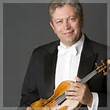
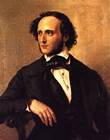 pictures: top: a bandoneon; above, L to R: Alexander Barantschik, Felix Mendelssohn; below, Astor Piazzola, Benjamin Britten.
pictures: top: a bandoneon; above, L to R: Alexander Barantschik, Felix Mendelssohn; below, Astor Piazzola, Benjamin Britten.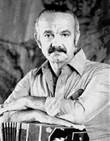
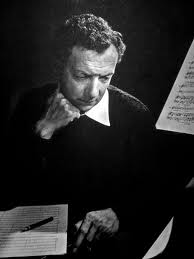
Andras Schiff/Bach
 Andras Schiff performed J.S. Bach’s Six Partitas for Keyboard, BWV 825-830, Sunday, October 6, at San Francisco’s Davies Symphony Hall. “Awesome” was the comment of the Hedgehog’s co-editor, a man seldom given to exaggeration or the use of that word to describe a sandwich. It was an awe-inspiring event. For readers who were not there, I will try to describe this once in a lifetime experience and also urge upon you attendance at one of Mr. Schiff’s performances or, if that is not possible, a careful listen to one of his recordings. I had the privilege to hear Mr. Schiff on his earlier visit to San Francisco in which he both played and talked about Bach. While I wanted to write about what he said and did, I put it off; perhaps I imagined that some how my ordinary brain would wake up to a set of words to match the music. That did not happen. The Partitas are multi-movement suites. Each is different; one can not anticipate, “oh, there’s the Sarabande, here comes the Gigue.” Bach uses those dance forms ( yes, conservatory students, dance forms ) in wholly new ways of his limitless invention. He adds movements called “galanterien,” optional movements, that come from all sorts of forms: arias, capriccios, fantasias. Within each movement, there is more invention within and all around it. The rhythmic variety is dazzling. Both the right and left hand establish different, complex rhythms and then take off onto new ones. The result is beauty. It is beautiful in the way a sunset or a forest might be beautiful on one glance but more beautiful, a mysterious and challenging beauty, if one could look knowing that one was not seeing a static picture but myriad entities made up of countless atoms all in motion. It was a performance that required focus on the part of the audience. The focus and endurance of the artist is at a level combining the focus of a world champion chess player with a world champion Iron Man. Being a person who does neither chess nor Iron Man contests, I do not claim to know from the inside what that is like. I am reaching to understand. The performance of these technically wizardly compositions lasted about 2 hours and 45 minutes. I mention that lest someone think a solo performance would necessarily be brief. The first half included Partita No. 5, No. 3, No. 1, and No. 2. Each one contains delights. No. 5 has a Corrente movement which truly runs quick notes dashing through bright, happy harmonies. Its seventh and final movement is a thrilling Gigue which demands beyond virtuoso playing. The rhythmic inventions in No. 3 continually alter the listener’s perceptions and occasionally reveal just a glimpse of a dance. The stunning final movement, Capriccio, of No. 2 leaves the listener breathless. Partita No. 4 opened the first half offering part of an answer as to the artist’s choice of the order of the works. This Partita’s lyricism made it sound almost as though it were foretelling the musical future evolving into Romanticism. Bach’s genius transcends any classification by era or style, just as pure mathematics, another hobby this writer has yet to take up, knows no limits by year or geography. The Hedgehog co-editor told me after the concert that the Partitas are works that every serious piano student knows, or knows about, or has approached, although, he said, they are so very (extremely) difficult to play. Looking back, I realize how lucky I am that I was not familiar with these magnificent works. That is because when the final movement, a Gigue that took even the previous Gigues to another level of pure music and artistry, came suddenly to its end, the sudden gesture of both my hands to my mouth in amazement was entirely involuntary. Yes, 2 hours and 45 minutes without the many curtain calls and Mr. Schiff’s generous encore. I would have gladly stayed to hear it all again. Andras Schiff performs Bach’s Goldberg Variations and Beethoven’s Diabelli Variations, Sunday, Oct. 13, 7 p.m., Davies Symphony Hall, San Francisco.
Andras Schiff performed J.S. Bach’s Six Partitas for Keyboard, BWV 825-830, Sunday, October 6, at San Francisco’s Davies Symphony Hall. “Awesome” was the comment of the Hedgehog’s co-editor, a man seldom given to exaggeration or the use of that word to describe a sandwich. It was an awe-inspiring event. For readers who were not there, I will try to describe this once in a lifetime experience and also urge upon you attendance at one of Mr. Schiff’s performances or, if that is not possible, a careful listen to one of his recordings. I had the privilege to hear Mr. Schiff on his earlier visit to San Francisco in which he both played and talked about Bach. While I wanted to write about what he said and did, I put it off; perhaps I imagined that some how my ordinary brain would wake up to a set of words to match the music. That did not happen. The Partitas are multi-movement suites. Each is different; one can not anticipate, “oh, there’s the Sarabande, here comes the Gigue.” Bach uses those dance forms ( yes, conservatory students, dance forms ) in wholly new ways of his limitless invention. He adds movements called “galanterien,” optional movements, that come from all sorts of forms: arias, capriccios, fantasias. Within each movement, there is more invention within and all around it. The rhythmic variety is dazzling. Both the right and left hand establish different, complex rhythms and then take off onto new ones. The result is beauty. It is beautiful in the way a sunset or a forest might be beautiful on one glance but more beautiful, a mysterious and challenging beauty, if one could look knowing that one was not seeing a static picture but myriad entities made up of countless atoms all in motion. It was a performance that required focus on the part of the audience. The focus and endurance of the artist is at a level combining the focus of a world champion chess player with a world champion Iron Man. Being a person who does neither chess nor Iron Man contests, I do not claim to know from the inside what that is like. I am reaching to understand. The performance of these technically wizardly compositions lasted about 2 hours and 45 minutes. I mention that lest someone think a solo performance would necessarily be brief. The first half included Partita No. 5, No. 3, No. 1, and No. 2. Each one contains delights. No. 5 has a Corrente movement which truly runs quick notes dashing through bright, happy harmonies. Its seventh and final movement is a thrilling Gigue which demands beyond virtuoso playing. The rhythmic inventions in No. 3 continually alter the listener’s perceptions and occasionally reveal just a glimpse of a dance. The stunning final movement, Capriccio, of No. 2 leaves the listener breathless. Partita No. 4 opened the first half offering part of an answer as to the artist’s choice of the order of the works. This Partita’s lyricism made it sound almost as though it were foretelling the musical future evolving into Romanticism. Bach’s genius transcends any classification by era or style, just as pure mathematics, another hobby this writer has yet to take up, knows no limits by year or geography. The Hedgehog co-editor told me after the concert that the Partitas are works that every serious piano student knows, or knows about, or has approached, although, he said, they are so very (extremely) difficult to play. Looking back, I realize how lucky I am that I was not familiar with these magnificent works. That is because when the final movement, a Gigue that took even the previous Gigues to another level of pure music and artistry, came suddenly to its end, the sudden gesture of both my hands to my mouth in amazement was entirely involuntary. Yes, 2 hours and 45 minutes without the many curtain calls and Mr. Schiff’s generous encore. I would have gladly stayed to hear it all again. Andras Schiff performs Bach’s Goldberg Variations and Beethoven’s Diabelli Variations, Sunday, Oct. 13, 7 p.m., Davies Symphony Hall, San Francisco. 
Yefim Bronfman, Tchaikovsky, the San Francisco Symphony
 Yefim Bronfman performed Tchaikovsky’s Piano Concerto No. 1 with the San Francisco Symphony, September 14, 2013. My eyes open wide and I shake my head; I am startled by my good luck to have been there. Please do not listen to anyone who belittles Tchaikovsky. There are those who will do it because too many others like his music. Do not listen to that noise, listen to Tchaikovsky. Mr. Bronfman played with power, grace, and understanding. He played delicately. He played so fast that I could not believe anyone’s fingers could move that way. He created a musical world. The SF Symphony met his need for a great partner in building this world. I want to say it was monumental; it was, but that word does not express the movement and life in the music. Mr. Bronfman played it into life. It is music that does not suggest a story but brought me to tears. The magnificence of his performance filled the hall with love, desperation, exaltation, with Tchaikovsky. The SF Symphony’s Music Director, Michael Tilson Thomas’s programming brilliance put Prokofiev’s Third Symphony on the same concert, after intermission and a chance to catch one’s breath. The SF Symphony played it as an overwhelming musical experience. The symphony, premiered in 1929, is full of struggle. All of the instruments are engaged in the battle. Knowing that the Symphony has sources in Prokofiev’s opera, The Fiery Angel, it could be the absolute struggle between good and evil, but it is a symphony, not an opera. The music has jagged, stabbing sounds and a quieter theme for the horns. There is no relief; the instruments assert their desires. It is a devilish battle. Search Prokofiev on the internet. Under his picture the caption is “Ballet Composer.” It is another harsh irony pursuing Prokofiev through the new century. Yes, ballets and Peter and the Wolf, but also the depths of this fantastic, cruel, reality in his Third Symphony. Thinking about Tchaikovsky and Prokofiev, a line from W.H.Auden’s poem, In Memory of W.B. Yeats, comes to mind. “Mad Ireland hurt you into poetry.” Both Tchaikovsky and Prokofiev were set upon by Russian struggles. Was Tchaikovsky too Western to be accepted as a great Russian composer? Were Prokofiev’s operas elements of pre-Revolutionary decadence? The bureaucrats with guns as well as other composers shouted, “Yes!” Auden asked the poet “with your unconstraining voice/Still persuade us to rejoice;” that is what Tchaikovsky and Prokofiev both could do and did for music and for us. Auden won’t claim “rejoice” because all is well, but because they could write this music.
Yefim Bronfman performed Tchaikovsky’s Piano Concerto No. 1 with the San Francisco Symphony, September 14, 2013. My eyes open wide and I shake my head; I am startled by my good luck to have been there. Please do not listen to anyone who belittles Tchaikovsky. There are those who will do it because too many others like his music. Do not listen to that noise, listen to Tchaikovsky. Mr. Bronfman played with power, grace, and understanding. He played delicately. He played so fast that I could not believe anyone’s fingers could move that way. He created a musical world. The SF Symphony met his need for a great partner in building this world. I want to say it was monumental; it was, but that word does not express the movement and life in the music. Mr. Bronfman played it into life. It is music that does not suggest a story but brought me to tears. The magnificence of his performance filled the hall with love, desperation, exaltation, with Tchaikovsky. The SF Symphony’s Music Director, Michael Tilson Thomas’s programming brilliance put Prokofiev’s Third Symphony on the same concert, after intermission and a chance to catch one’s breath. The SF Symphony played it as an overwhelming musical experience. The symphony, premiered in 1929, is full of struggle. All of the instruments are engaged in the battle. Knowing that the Symphony has sources in Prokofiev’s opera, The Fiery Angel, it could be the absolute struggle between good and evil, but it is a symphony, not an opera. The music has jagged, stabbing sounds and a quieter theme for the horns. There is no relief; the instruments assert their desires. It is a devilish battle. Search Prokofiev on the internet. Under his picture the caption is “Ballet Composer.” It is another harsh irony pursuing Prokofiev through the new century. Yes, ballets and Peter and the Wolf, but also the depths of this fantastic, cruel, reality in his Third Symphony. Thinking about Tchaikovsky and Prokofiev, a line from W.H.Auden’s poem, In Memory of W.B. Yeats, comes to mind. “Mad Ireland hurt you into poetry.” Both Tchaikovsky and Prokofiev were set upon by Russian struggles. Was Tchaikovsky too Western to be accepted as a great Russian composer? Were Prokofiev’s operas elements of pre-Revolutionary decadence? The bureaucrats with guns as well as other composers shouted, “Yes!” Auden asked the poet “with your unconstraining voice/Still persuade us to rejoice;” that is what Tchaikovsky and Prokofiev both could do and did for music and for us. Auden won’t claim “rejoice” because all is well, but because they could write this music.